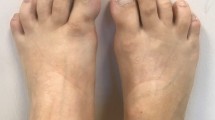Abstract
Fibrodysplasia ossificans progressiva (FOP) is a rare catastrophic genetic condition of extraskeletal (heterotopic) ossification. One in every two million people is affected worldwide, with no ethnic, racial, gender, or geographic predisposition. Most cases of FOP arise from a spontaneous missense mutation in the gene encoding bone morphogenic protein (BMP) type II receptor (ACVR1/ALK2). Affected individuals are normal at birth apart from malformed great toes. Onset of clinical symptoms is usually in the first decade of life, presenting with episodic emergence of painful rapidly appearing tumor-like soft tissue swellings (flare-ups). Heterotopic bone replaces the skeletal muscles, tendons, ligaments, and connective tissue at the site of the damage through a process of endochondral ossification, causing fixation of joints and permanent limitation of motion. Most affected individuals are confined to wheelchair in the third decade of life. Worldwide rate of misdiagnosis of FOP is very high; clinicians often fail to associate the two classic clinical features of FOP: rapidly developing soft tissue swellings and the abnormal great toes. The current case presents a previously undiagnosed 39-year-old FOP patient, sadly a victim of lack of clinical awareness of this rare condition. As a result of repetitive iatrogenic harm, he has tragically “turned into stone.”




Similar content being viewed by others
References
Kaplan FS, Le Merrer M, Glaser DL, Pignolo RJ, Goldsby R, Kitterman JA, Groppe J, Shore EM (2008) Fibrodysplasia ossificans progressive. Best Pract Res Clin Rheumatol 22(1):191–205
Kaplan FS, Chakkalakal SA, Shore EM (2012) Fibrodysplasia ossificans progressiva: mechanisms and models of skeletal metamorphosis. Dis Model Mech 5(6):756–762
Kaplan FS, Groppe J, Shore EM (2008) When one skeleton is enough: approaches and strategies for the treatment of fibrodysplasia ossificans progressiva (FOP). Drug Discov Today Ther Strateg 5(4):255–262
Raees-Karami SR, Jafarieh H, Ziyayi V, Shekarriz Foumani R, Aghighi Y (2012) Evaluation of 20 years experience of fibrodysplasia ossificans progressiva in Iran: lessons for early diagnosis and prevention. Clin Rheumatol 31(7):1133–1137
Pignolo RJ, Shore EM, Kaplan FS (2011) Fibrodysplasia ossificans progressiva: clinical and genetic aspects. Orphan J Rare Dis 6:80
Dua SG, Purandare NC (2011) Are great toes always abnormal in patients with fibrodysplasia ossificans progressiva? Eur J Pediatr 170(4):541–543
Kaplan FS, Glaser DL, Shore EM et al (2005) The phenotype of fibrodysplasia ossificans progressiva. Clin Rev Bone Miner Metab 3(3–4):183–188
Al-Haggar M, Ahmad N, Yahia S, Shams A, Hasaneen B, Hassan Hassan R, Wahba Y, Salem NA, and Abdel-Hady D (2013) Sporadic Fibrodysplasia Ossificans Progressiva in an Egyptian Infant with c.617G > A Mutation in ACVR1 Gene: A Case Report and Review of Literature. Case Rep Genet. 2013: 834605.
Pignolo RJ, Suda RK, Kaplan FS (2005) The fibrodysplasia ossificans progressiva lesion. Clin Rev Bone Miner Metab 3:195–200
Hashemi J, Shahfarhat A, Beheshtian A (2011) Iran fibrodysplasia ossificans progressiva: report of a case and review of articles. Iran J Radiol 8(2):113–117
Rogers JG, Geho WB (1979) Fibrodysplasia ossificans progressiva. A survey of forty-two cases. J Bone Joint Surg 61A:909–914
Schroeder HW, Zasloff MA (1980) The hand and foot malformations in fibrodysplasia ossificans progressiva. Johns Hopkins Med J 147:73–78
Connor JM, Evans DA (1982) Fibrodysplasia ossificans progressiva: the clinical features and natural history of 34 patients. J Bone Joint Surg 64B:76–83
Smith R (1998) Fibrodysplasia (myositis) ossificans progressiva: clinical lessons from a rare disease. Clin Orthop Rel Res 346:7–14
Cohen RB, Hahn VG, Tabas JA et al (1993) The natural history of heterotopic ossification in patients who have fibrodysplasia ossificans progressiva: a study of forty-four patients. J Bone Joint Surg 75A:215–219
Kaplan FS, Zasloff MA, Kitterman JA, Shore EM, Hong CC, Rocke DM (2010) Early mortality and cardiorespiratory failure in patients with fibrodysplasia ossificans progressiva. J Bone Joint Surg Am 92(3):686–691
Kaplan FS, Xu M, Glaser DL, Collins F, Connor M, Kitterman J, Sillence D et al (2008) Early diagnosis of fibrodysplasia ossificans progressiva. Pediatrics 121(5):e1295–e1300
Deirmengian GK, Hebela NM, O'Connell M, Glaser DL, Shore EM, Kaplan FS (2008) Proximal tibial osteochondromas in patients with fibrodysplasia ossificans progressiva. J Bone Joint Surg Am 90(2):366–374
Zaghloul KA, Heuer GG, Guttenberg MD, Shore EM, Kaplan FS, Storm PB (2008) Lumbar puncture and surgical intervention in a child with undiagnosed fibrodysplasia ossificans progressiva. J Neurosurg Pediatr 1(1):91–94
Puszczewicz M, Kołczewska A, Zimmermann-Górska I, Majewski D, Ogrodowicz A (2007) Fibrodysplasia ossificans progressiva: case report. Pol Arch Med Wewn 117(1–2):53–56 [Article in Polish]
Kitterman JA, Kantanie S, Rocke DM, Kaplan FS (2005) Iatrogenic harm caused by diagnostic errors in fibrodysplasia ossificans progressiva. Pediatrics 116(5):e654–e661
Kaplan FS, Tabas J, Gannon FH, Finkel G, Hahn GV, Zasloff MA (1993) The histopathology of fibrodysplasia ossificans progressiva: an endochondral process. J Bone Joint Surg 75(2):220–230
Shore EM, Feldman GJ, Xu M, Kaplan FS (2005) The genetics of fibrodysplasia ossificans progressiva. Clin Rev Bone Miner Metab 3(3– 4):201–204
Kaplan FS, Shen Q, Lounev V, Seemann P, Groppe J, Katagiri T, Pignolo RJ, Shore EM (2008) Skeletal metamorphosis in fibrodysplasia ossificans progressiva (FOP). J Bone Miner Metab 26(6):521–530
Bridges AJ, Hsu KC, Singh A, Churchill R, and Miles J (1994) Fibrodysplasia (myositis) ossificans progressiva Semin Arthritis Rheum. 24(3):155–64
Disclosures
None.
Author information
Authors and Affiliations
Corresponding author
Electronic supplementary material
Below is the link to the electronic supplementary material.
The Patient was incapable of sitting or bending. He needed assistance to lie down. (MPG 5743 kb)
Rights and permissions
About this article
Cite this article
Taslimi, R., Jafarpour, S. & Hassanpour, N. FOP: still turning into stone. Clin Rheumatol 34, 379–384 (2015). https://doi.org/10.1007/s10067-013-2417-x
Received:
Revised:
Accepted:
Published:
Issue Date:
DOI: https://doi.org/10.1007/s10067-013-2417-x




